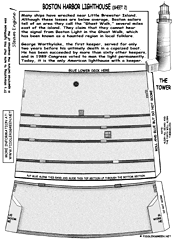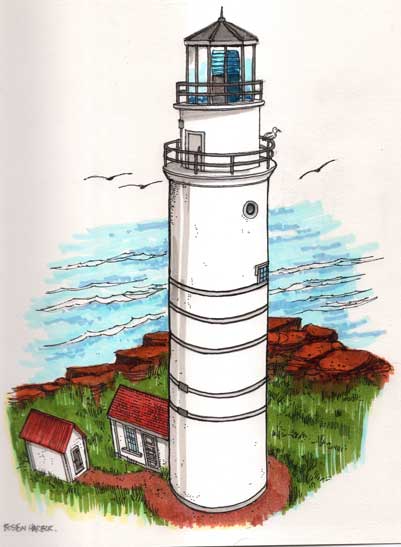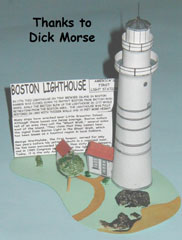

Boston, MA - $$3.95
Boston Harbor Lighthouse is the oldest navigational station in all of North America. Built in 1716 on Little Brewster island at the entrance to the harbor, it helped attract the fleets of trading ships that made Boston one of the world's most prosperous cities. In 1964 it was designated as a National Historic Landmark. It is the only lighthouse still run by the coast guard. It stands 89 feet and has been called the "ideal American lighthouse". In 1948, Boston Harbor Lighthouse was electrified. It was also the last American lighthouse to be automated.
Boston Harbor Lighthouse on Little Brewster Island, MA
 Is the oldest navigational station in all of North America. Built in 1716 on Little Brewster island at the entrance to the harbor, it helped attract the fleets of trading ships that made Boston one of the world's most prosperous cities.
Is the oldest navigational station in all of North America. Built in 1716 on Little Brewster island at the entrance to the harbor, it helped attract the fleets of trading ships that made Boston one of the world's most prosperous cities.At the beginning of the Revolutionary War in 1775, Boston was the garrison of the British army in North America. Attacked twice by Patriot militiamen, the British destroyed the lighthouse. After the war, a new tower, 75 feet high, was completed and has withstood more than 200 years of wind and water.
Many ships have wrecked near Little Brewster Island. Although these losses are below average, Boston sailors tell of an area they call the "Ghost Walk," several miles east of the island. They claim that they cannot hear the signal from Boston Light in the Ghost Walk, which has been known as a haunted region in New England folklore.
For many years the bulk of the country's lighthouses clustered in New England. In 1825, for example, nearly two-thirds of them were located between New York City and West Quoddy, Maine a distance of less than 600 miles. There were several reasons for such heavy concentration in this relatively small section of the coast. The basic one was that the shipping industry centered at that time in New England. Of course, no one would deny that the area's rock-bound coast, liberally dotted with offshore islands and shoals, called for aids to navigation; no one begrudged New England a single lighthouse, buoy, or light beacon, Moreover, the system of establishing lighthouses in use at that time that is, responding principally to local agitation favored New England because its population, heavily centralized along coastal areas, was deeply interested in shipping activities.
The pattern for this concentration of lighthouses had been set during the colonial period; after all, nine of the colonies' eleven lighthouses were located from Delaware Bay northward. Indeed, seven of them were situated on the coast between New London, Connecticut, and Portland in southern Maine.
After the Revolution, New England retained its preeminence in maritime activity, and as a result, the number of lighthouses increased overwhelmingly along her coast. Of the fourteen lighthouses built between the end of the war and 1799, all but four were north of New York City. And the following twenty years saw little change in this ratio. Only six of the twenty-six lighthouses erected in the 1801-1820 period guarded shores south of Delaware Bay. In other words, in 1820 the coast from Delaware Bay northward possessed 75 percent of the nation's lighthouses.
One should not draw any inference of sectional rivalry from
these statistics. There is no evidence that the southern states
felt any discrimination in the lighthouse field. These figures
reflect only greater seafaring activities in the northern states.
The foundation and nucleus of the lighthouse service in New England were, of course, the colonial lighthouses. At the end of the Revolution, less than half these lighthouses were still operating; consequently, the various ex-colonies went about repairing these lights and making them operable.
Boston Lighthouse (1716)
Boston lighthouse on Little Brewster Island received immediate attention. In 1783, the Massachusetts legislature provided over $1,400 to rebuild the war-damaged tower and to secure a suitable light. The workmen erected a conical stone tower seventy-five feet tall, and the keeper lighted its several lamps in December, 1783. The state operated the light until June 10, 1790, when, in accordance with recently enacted federal law, it turned the station over to the central government. The colonial practice of letting the keeper also serve as a harbor pilot continued under federal government rule, and in 1838, a naval officer inspecting lighthouses at the request of the Treasury Department complained that the keeper's piloting duties caused him often to neglect his lighthouse responsibilities. This practice apparently ceased prior to 1851, for in their report the Lighthouse Board did not mention it; and that sort of thing the Lighthouse Board would not have overlooked. Also, sometime prior to 1851, the wooden interior tower stairway was removed and a metal stairway installed. By that time the tower had been recently equipped with new twenty-one-inch English parabolic reflectors, and seamen considered Boston light the best of the reflector type on the United States coast-which doesn't speak well, however, for the American-produced reflectors. Nevertheless, the board felt the tower was too short, and in 1859 it had the tower raised fourteen feet so that the top of the lantern was eighty-nine feet above ground. At the same time, the tower, which the board bad previously noted as being cracked, was strengthened with a lining of brick. In addition, where the outer masonry bulged, workmen removed stones and patched the tower with brick. A new second-order Fresnel lens completed the renovation. Since then, the light has served faithfully, except for a period during World War 11 when the Coast Guard extinguished it for security reasons.
Until the late 1840's, the cannon remained the station's fog signal. Around 1850, a fog bell, weighing nearly three-quarters of a ton, was installed. In 1872, the Lighthouse Board installed a more modern fog trumpet, and fifteen years later had a steam siren placed at the station.
Despite the warning supplied by the light and the fog signal during inclement weather, several ships have come to their end virtually at the doorstep of the Boston light. In 1861, the Miranda, a square-rigger, ran on the rocks near Brewster Island in a snow storm and left but twelve survivors. The schooner Calvin F. Baker during a gale in 1898 also smashed onto rocks near the lighthouse; she lost at least three crewmen, who froze to death in the rigging.
The Boston light is the country's first, and therefore oldest, light station. Its tower, though of an early vintage, is not the country's oldest-Sandy Hook rates that honor. The Boston tower of colonial days was destroyed by the British when they evacuated Little Brewster in 1776. According to some accounts, the British placed their charge of black powder under the structure when they blew it up.
The state of Massachusetts rebuilt the tower on the same island in 1783. There is no documentary evidence that the builders reconstructed the tower on the undamaged portion of the old tower, if there was even any usable portion left. The only time the tower seems to have been built on was in 1859 when the Lighthouse Board raised the tower to its present height.
The tower's extraordinary longevity is no accident. Aware the lighthouse could face other wars, not to mention fierce battles with Atlantic storms, the Boston masons who built the 1783 tower gave it walls more than seven feet thick at the base. In 1853 its height was raised by fifteen feet and its stone walls lined with brick. Otherwise, except for reinforcing steel hoops added in 1983, the tower remains essentially unchanged.
 Nearly as venerable as the tower itself is the second-order
Fresnel lens installed here in 1859. It remains in service, producing
a flashing white light visible from an impressive distance of
more than twenty-seven miles at sea. The nation's last remaining
resident lighthouse keepers carefully attend the lens. The U.S.
Coast Guard runs this light station the old way, with keepers
on site around the clock, as a sort of living memorial to a centuries-old
tradition.
Nearly as venerable as the tower itself is the second-order
Fresnel lens installed here in 1859. It remains in service, producing
a flashing white light visible from an impressive distance of
more than twenty-seven miles at sea. The nation's last remaining
resident lighthouse keepers carefully attend the lens. The U.S.
Coast Guard runs this light station the old way, with keepers
on site around the clock, as a sort of living memorial to a centuries-old
tradition.
Travel information: Little Brewster island is part of Boston
Harbor Islands State Park. Call (781) 740-4290 for advice on viewing
the lighthouse. Harbor cruises offering close-up views of the
Boston Lighthouse and nearby Graves Ledge Lighthouse are available
much of the year. For lists and schedules call the Greater Boston
Area Visitors Center at (781) 536-4100. Airliners landing at Boston's
Logan Airport offer thrilling views of these lighthouses and the
Long Island Head Lighthouse (1919), near the inner harbor.
Boston Light was built on what is now called Little Brewster
Island by the Province of Massachusetts  Bay in 1716. It was the
first lighthouse in the thirteen colonies, a cone-shaped stone
tower, lit first by tallow candles and later by an oil lamp.
Bay in 1716. It was the
first lighthouse in the thirteen colonies, a cone-shaped stone
tower, lit first by tallow candles and later by an oil lamp.
At the beginning of the Revolutionary War in 1775, Boston was the garrison of the British army in North America. Attacked twice by Patriot militiamen, the British destroyed the lighthouse.
After the war, a new tower, 75 feet high, was completed and has withstood more than 200 years of wind and water. In 1859 a second order Fresnel lens of 1,800,000 candlepower was installed, and is visible 16 miles from shore.
Many ships have wrecked near Little Brewster Island. Although these losses are below average, Boston sailors tell of an area they call the "Ghost Walk," several miles east of the island. They claim that they cannot hear the signal from Boston Light in the Ghost Walk, which has been known as a haunted region in New England folklore.


